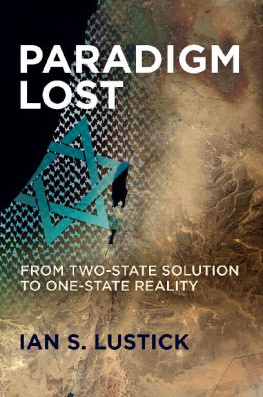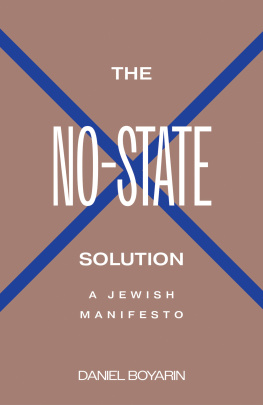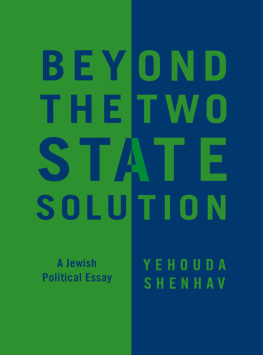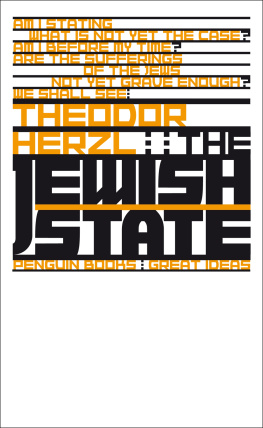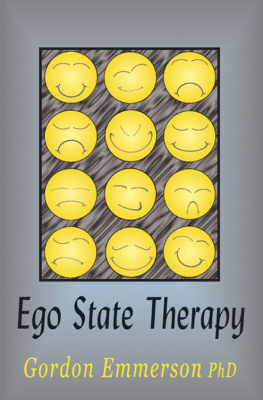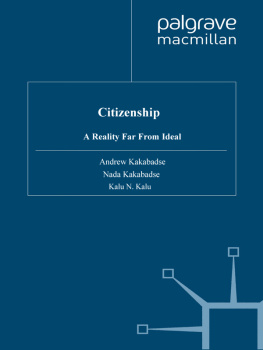Paradigm Lost
Paradigm Lost
From Two-State Solution to One-State Reality
Ian S. Lustick
Copyright 2019 University of Pennsylvania Press
All rights reserved. Except for brief quotations used for purposes of review or scholarly citation, none of this book may be reproduced in any form by any means without written permission from the publisher.
Published by
University of Pennsylvania Press
Philadelphia, Pennsylvania 19104-4112
www.upenn.edu/pennpress
Printed in the United States of America on acid-free paper
10 9 8 7 6 5 4 3 2 1
Library of Congress Cataloging-in-Publication Data
ISBN 978-0-8122-5195-1
For Terri, the love of my life,
and to the memory of my brother David
Sounded like the truth
Seemed the better way
Sounded like the truth
But its not the truth today
Leonard Cohen
Man plans and God laughs.
Yiddish proverb
Contents
Introduction
Zionists saw more clearly than anyone else the catastrophe facing the Jews of Europe and the need for a refuge. Their campaign to transform all or most of Palestine into a Jewish state succeeded in 1948. The Israeli-Palestinian conflict arose from that success and from two refusals. The first, when Israel refused to allow three-quarters of a million Palestinian Arabs to return to their homes, created the Palestinian refugee problem and ensured deep and continued challenges to its peace and security. A second and far more protracted refusal stretched over decades following the Six-Day War of 1967. In this period, Israel prevented a Palestinian state or entity of any kind from being established in the West Bank and the Gaza Strip. Israel thereby destroyed the one option available for a negotiated compromise capable of ending not only the Palestinian-Israeli dispute but also the larger Arab-Israeli conflict. This second decades-long refusal and its consequences are the focus of this book.
The odds of a two-state solution (TSS) were never favorable, but opportunities to negotiate were present from soon after the 1967 war to the collapse of the Oslo peace process in 2000. By the early twenty-first century, however, it became impossible to explain how a TSS could materialize and deeply implausible to expect one. TSS diehards still say that splitting the country into two states can be done and that the establishment of a single state is impossible. In principle, two states might someday emerge in Palestine. But the hard truth is that such an arrangement will not and can no longer come about from negotiations. Partly by design and partly by accident, Israeli policies have established another hard truth. There is today one and only one state ruling the territory between the Mediterranean Sea and the Jordan River, and its name is Israel. To be sure, the government of Israel rules different territories and groups of people between the sea and the river according to different laws and norms and with different degrees of authority and regularity. But if a state is defined to mean an entity with ultimate control over the security of life and property, then no inhabitant of this area, whether in Tel Aviv, Nablus, Haifa, or Gaza, lives in any state other than Israel. So, not only is one state that rules large Jewish and Arab populations in Palestine/the Land of Israel not impossible, it is also reality. It already exists.
No blueprint for the resolution of the Zionist-Palestinian Arab or Israeli-Palestinian conflict has had better prospects for success than the creation of two-states for two peoples in one land. Such an arrangement would have protected the most cherished objective of the Zionist movementa viable, recognized state in the Land of Israel inhabited by a large majority of Jewswhile providing Palestinians with the protection and satisfaction of a viable state. The failure to achieve some version of that scheme before it became impossible to achieve through negotiations is a great historical and political tragedy that requires much deeper examination and an explanation compelling enough, perhaps, to push Israeli-Palestinian politics in a new direction.
Although the TSS is dead, its ghost remains, not as an inspiring blueprint for action but as distracting dogma. The ghost of the TSS haunts the conflict and obscures the reality that all of Palestine is controlled by one state, and the name of that state is Israel. With the false but seductive promise of its own resurrection, the TSS diverts attention from key questions about the nature of the Israeli state today and about whether or how the nature of its rule over the different territories included within it could change. The mirage of the TSS justifies the treatment of an increasingly oppressive status quo as a necessary but temporary evil. It prevents those who favor a democratic future from working effectively to bring that about while abetting those who favor nondemocratic outcomes.
The false belief in a negotiated TSS survives because advocates and opponents both cherish it as a useful fiction, the former as a yearned-for fantasy and the latter as a usefully conjured nightmare. The baleful legacy of the TSSwhich blocks useful thinking about the future and abets the unannounced consolidation of a regime based on discrimination and coercioncan only be counteracted by an equally strong understanding of the structural barriers in Israelcultural, psychological, and politicalthat crippled its chances for success. These obstacles are much more fundamental than the widely appreciated difficulties posed by more than 620,000 Israeli settlers in the West Bank (including expanded East Jerusalem) and other well-documented processes of de facto annexation. They include the historical consequences of Zionisms initial failure to address Arab requirements, the way that the Holocaust and its lessons were eventually construed and enshrined in Israeli political culture, and the drastic distortion of Israeli politics resulting from an American foreign policy implemented mainly in conformity with the demands of the Israel lobby in the United States. This book examines the contribution of each of these obstacles to the failure of the TSS, leading up to an exploration of how that analysis can guide new thinking about the future of all the people living between the river and the sea, no matter what their ethnicity, religion, or citizenship status.
From the late 1960s to the end of the first decade of the twenty-first century, I was an active participant in the TSS project and considered it a worthy struggle. Certainly, the TSS would have brought its own problems, but these would have been more manageable than those in its absence. A Palestinian state could have been established and could have coexisted peacefully alongside Israel, but the opportunity to establish it was historically perishable and is no longer available.
Neither Zionists nor Arabs were ever uniformly and sincerely committed to a TSS. Certainly, Israeli leaders are not the only ones who contributed to failure of the TSS project. Nevertheless, given Israels overwhelming political and military power vis--vis the Palestinians, and its virtually complete control of developments on the ground in the West Bank and Gaza, the TSSs failure to launch was primarily a function of Israels behavior.
This disproportionate responsibility is obvious not just in hindsight. It was obvious a hundred years ago that getting Palestines Arabs to reconcile with a Jewish state in their country would be difficult if not impossible. Most Zionists early in the twentieth century knew it was completely unrealistic to imagine that the indigenous population of Palestine would welcome the colonization of their country and its deliverance into the hands of another people. I dont know of a single example in history, said Vladimir Jabotinsky, leader of the right wing of the Zionist movement, where a country was colonized with the courteous consent of the native population. At the inception of the movement, Zionists well knew that if the Arabs of Palestine were ever to accept Zionism, it would be the result of bitter resignation after decades of fierce resistance.



